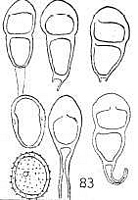|
 Puccinia punctata Puccinia punctata
BiostatusPresent in region - Indigenous. Non endemic
Images (click to enlarge)
Caption: FIG. 83. Puccinia punctata Link. on Galium umbrosum Sol. Teleutospores and
uredospores. |
Article: Cunningham, G.H. (1924). The Uredinales, or rust-fungi, of New Zealand: supplement to Part 1; and Part 2. Transactions and Proceedings of the New Zealand Institute 55: 1-58 Wellington:.
Description: 0. Spermogones epiphyllous, sparse, in small groups, honey-coloured.
I. Aecidia hypophyllous, in small groups, or scattered, seated on pallid spots, orange-yellow.
Peridia cupulate, 0.25 mm. diam., margins short, erect, or somewhat recurved, finely
laciniate, white. Spores globose or elliptical, 16-24 X 16-22 mmm.; epispore hyaline, densely
and minutely verruculose, 1 mmm. thick, cell-contents orange-yellow.
II. Uredosori amphigenous, chiefly hypophyllous, and caulicolous, on leaves scattered,
orbicular, 0.5-1 mm. diam., on stems elliptical, up to 2 mm. long, cinnamon - brown,
pulverulent, surrounded by the ruptured epidermis. Spores elliptical, obovate or subglobose,
22-28 X 18-22 mmm.; epispore pallid cinnamon-brown, sparsely and moderately echinulate,
1.5 mmm. thick, cell-contents vacuolate, cinnamon; germ-pores 2, super-equatorial,
conspicuous.
III. Teleutosori hypophyllous and caulicolous, minute, orbicular, 0.25-1 mm. diam.,
chocolate-brown, pulvinate, semi-compact, surrounded by the ruptured epidermis. Spores
clavate, less commonly elliptical, 35-50 X 15-22 mmm.; apex rounded, seldom acuminate,
thickened up to 14 mmm.; base attenuate, lower cell narrower and lighter in colour than the
upper; slightly constricted at the septum; epispore smooth, golden-brown, 2 mmm. thick in
upper cell, 1.5 mmm. in lower; pedicel persistent, hyaline, tinted at the apex, up to 40 X 10
mmm.; germ-pore of the upper cell apical, conspicuous, basal pore immediately beneath the
septum, obscure.
X. Mesospores common, obovate or elliptical, 25-35 mmm. long.
Distribution: Distribution: Europe; Siberia; North America; Chile.
Notes: Both hosts are endemic and common throughout. Cheeseman (1906: p. 267) states that
Asperula perpusilla would almost be better placed in Galium, as the corolla-tube (the only
character upon which the genus is separated from Galium) is much shorter than is usual in
this genus.
Several species are recorded as occurring on Galium in Europe. Of these, P. difformis K. et
S. differs in the uredosori being absent; P. Valantiae Pers. in both aecidia and uredosori
being absent; and P. Celakovskyana Bubak in the absence of aecidia. P. Asperulae-odoratae Wurth is
separated, as it occurs on Asperula. and is unable to infect Galium;
morphologically it is practically identical with P. punctata, so that I can see no valid reason
for maintaining it other than as a biological form of this latter species.
In Australia McAlpine (1906, pp.. 91 and 165) records two rusts, Uromyces Asperulae
McAlp. and Puccinia Oliganthae McAlp., as occurring on Asperula. The latter species
closely resembles P. punctata, but differs in the more acuminate and narrower teleutospore.
In our form the aecidia differ slightly from the European in being amphigenous and
caulicolous, but, as the peridial and spore characters are identical, I have thought it better to
maintain all spore forms under the one name.
Article: Dingley, J.M. (1969). Records of plant diseases in New Zealand. New Zealand Department of Scientific and Industrial Research, Bulletin 192: 298 p. Wellington:.
Notes: All three host plants [Galium spp.] are endemic to New Zealand; the rust is sporadic in its
occurrence in this country.
|